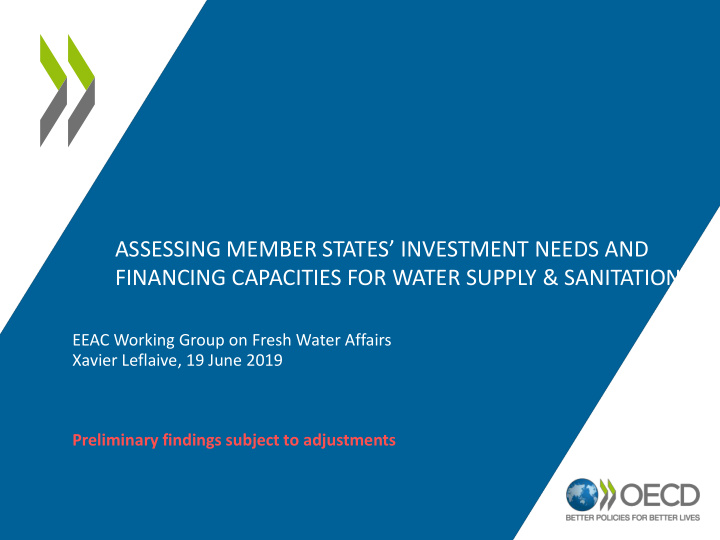



ASSESSING MEMBER STATES’ INVESTMENT NEEDS AND FINANCING CAPACITIES FOR WATER SUPPLY & SANITATION EEAC Working Group on Fresh Water Affairs Xavier Leflaive, 19 June 2019 Preliminary findings subject to adjustments
Scope • Water-related investments to 2050 – Water supply – Wastewater collection and treatment – Flood protection • Pending issues – Compliance with Water Framework Directive – Climate change – Contaminants of emerging concern 2
Characterising the financing challenge Macroeconomic affordability Source : OECD analysis based on EUROSTAT (WSS-related public and household expenditures, GDP, population). 3
Per capita cumulative additional expenditures by 2030: BAU + Compliance + efficiency Romania Bulgaria Ireland Croatia Luxembourg: Cyprus EUR 2928 (BAU: 2782; Spain WS:146; WW: 0) Commission and Eurostat data Source : OECD analysis based on European Netherlands Slovakia Italy United Kingdom Austria Denmark BAU Malta Compliance and efficiency WS Belgium Compliance WW Sweden France Germany Portugal Poland Slovenia Czech Republic Latvia Finland Hungary Estonia Lithuania Greece 4 EUR 0 100 200 300 400 500 600 700 800 900
Sources of finance for water supply and sanitation services per member state Sweden Household expenditure data unavailable Croatia Ireland Luxembourg purpose, Mean consumption expenditure by detailed COICOP level). institutional sector, Final consumption expenditure of households by consumption function, Final consumption expenditure on environmental protection services by Source : OECD analysis based on EUROSTAT (General government expenditure by Cyprus Netherlands Slovenia Hungary Estonia France Malta Spain Greece Romania Latvia Czech Republic Poland Austria Lithuania Bulgaria Slovakia Portugal Germany Belgium Italy Finland United Kingdom 2011-15 Denmark annual average 0% 20% 40% 60% 80% 100% 5 Public budget Revenues from water tariffs
6 Note : It is assumed that EU transfers are always channelled through domestic budgets of each member states and that they are, therefore not additional to government expenditures . Source : OECD analysis based on EUROSTAT (for past estimated 2011-15 average annual expenditures), European Commission Directorate-General for Regional and Urban Policy (Open Data Portal for European Structural and Investment Funds). Share of EU transfers in estimated total 100% 90% expenditures for WSS per country 80% 70% 60% 50% 40% 30% 20% 10% 0% Estonia Romania Latvia Bulgaria Lithuania Greece Hungary Slovakia Croatia Slovenia Malta Portugal Poland Spain Czech Republic Cyprus Italy Ireland Germany France Finland United Kingdom Sweden Netherlands Luxembourg Denmark Belgium Austria
Share of WSS expenditures in households’ disposable income Note : Lack of household expenditure data for Croatia and Sweden. Source : OECD analysis based on EUROSTAT (household expenditures and income data) 2011-15 annual average 7
Raising water tariffs towards full-cost recovery of current expenditures Note : Lack of household expenditure data for Croatia and Sweden. Known underestimate of total expenditures for Finland and Sweden. Source : OECD analysis based on EUROSTAT (household expenditures and income data) 2011-15 annual average 8
Options to bridge the gap This is not all about more money • Minimise investment needs – Avoid building future liabilities – Enhance operation of existing assets • Make the best use of available resources – Plan and set priorities – Explore Nature-based solutions (UK, EIB…) • Enhance the quality of investment – WSS: Portugal – Policy coherence – The benefit of technical innovation • Crowd in new sources of finance – Beneficiaries (property developers) – Domestic commercial finance (blending) 9
Recommend
More recommend